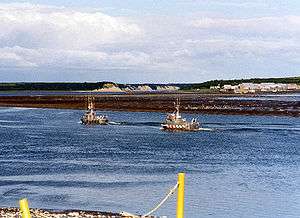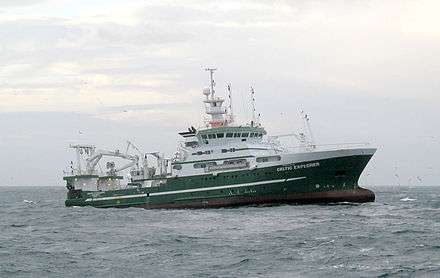Aquaculture in Alaska
Aquaculture in Alaska is dominated by the production shellfish and aquatic plants. These include Pacific oysters, blue mussels, littleneck clams, scallops, and bull kelp. Finfish farming has been prohibited in Alaska by the 16.40.210 Alaskan statute, however non-profit mariculture continues to provide a steady supply of aquaculture in the state. Many organizations that helped the ban, now encourage the growing of shellfish and other oysters.[1]
Overview

Alaskan aquaculture is an important resource not just for the state, but for the entire country. Alaska is filled with a variety of aquatic fish, shellfish, plants, and other species that all play an important role in the aquaculture process. Commercial salmon and herring fisheries dominate Alaskan harvesting and production and harvesting sights are located on the coast line throughout the state, producing an average of 750 million pounds each year. Commercial shellfish fisheries also greatly contribute to annual statistics and at its high point 400 million pounds of shellfish have been produced in one year.[2]
Cultured Species
Salmon
The commercial fishing of returning salmon to Alaskan waters provide one of the most important industries in Alaska. Beginning in the 1880s, commercial salmon fishing has become a dominant area of Alaskan aquaculture, although hatchery salmon still make up the minority of the catch. Over the course of four years the average salmon harvest by commercial fishermen was approximately 157 million fish or 742 million pounds and averaged an annual value of over $230 million. Many inhabitants of Alaska greatly rely on the salmon harvest each year for income and cultural purposes. Major salmon fisheries in Alaska are located in the Yukon, Bristol Bay, Southeast/Yakutat, Cook Inlet, Chignik/Kodiak, Copper River, and Prince William Sound areas.[3]
Herring
Beginning in the 1880s, commercial herring ocean ranching has continued to support commercial fisheries and feed the Alaskan people. Herring are harvested in late summer to fall in southern Alaska and Norton Sound areas after the spawning process has taken place. Spawning begins in the early spring in Southern Alaska and ends in the middle of the summer months in the northern Bering Sea. Major commercial herring fisheries are located in the Norton Sound, Cape Romanzof, Kuskokwi, Bristol Bay, Alaskan Peninsula, Kodiak, Prince William Sound, and Southeast Alaska areas. Herring eggs can also be harvested after they are deposited by the herring on shoreline vegetation, which includes wild and Pound kelp.
Crabs
Crabs are a dominant and famous source of aquaculture found in Alaska, particularly the king crab, which includes the varieties of blue, scarlet, golden, and red. Red king crabs dominate over the other species in commercial harvesting and are most commonly found in the Bristol Bay area and less commonly but still found in the Southeast, Norton Sound, and Adak areas. Other important crabs harvested in Alaskan areas include the Tanner crab, snow crab, and Dungeness crab.
Shrimp
In the 1980s shrimp production was a key and important role in Alaskan shellfish harvests but an increase in Pacific cod caused shrimp production to decrease. Small trawl shrimp fisheries are still located in Southeast Alaska, Kodiak, Bering Sea, and Aleutian Island areas.[4]
Other Species
Clams- Alaska has clam fisheries in Southeast Alaska and fisheries in the Cook Inlet specifically for razor clams.
Scallops- Scallops are dredged off the Eastern Gulf of Alaska and continue to be the overall largest commercial species in the world.
Sea Cucumbers- Sea cucumbers are harvested in Southeast Alaska during the winter months in dive fisheries.
Octopus- octopuses and squid harvesting occur in the Bering Sea and Gulf of Alaska for commercial purposes.
See also
- Alaska salmon fishery
- Cook Inlet Aquaculture Association
- Southern Southeast Regional Aquaculture Association
References
- ↑ Martin, James D. "Alaska seeks to establish oyster industry." Feedstuffs 29 Jan. 2001: 29. Expanded Academic ASAP. Web. 14 Oct. 2009
- ↑ http://www.cf.adfg.state.ak.us/geninfo/geninfo.php
- ↑ Woodby, Doug, et al. Alaska Department of Fish and Game. Spec. issue of Commercial Fisheries in Alaska Special Publication 05-09 (2005): 1-66. PDF-1,059K file. Alaska Dept. of Fish and Game <http://www.sf.adfg.state.ak.us/FedAidPDFs/sp05-09.pdf>.
- ↑ http://www.questia.com/PM.qst?a=o&d=96414617
